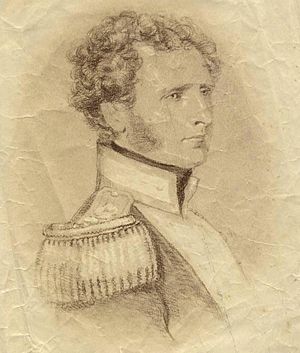Henry Edward Napier facts for kids
Quick facts for kids
Henry Edward Napier
|
|
|---|---|

Henry Edward Napier
|
|
| Born | 5 March 1789 |
| Died | 13 October 1853 (aged 64) London, England |
| Allegiance | United Kingdom |
| Service/ |
Royal Navy |
| Years of service | 1803–1830 |
| Rank | Captain |
| Commands held |
|
| Battles/wars | Napoleonic Wars |
Henry Edward Napier (born March 5, 1789 – died October 13, 1853) was a British naval officer and a historian. He spent many years serving in the Royal Navy. Later in life, he became known for writing a detailed history book.
Contents
Meet Henry Edward Napier's Family
Henry Edward Napier was the fifth son of Colonel George Napier. His mother was Lady Sarah Lennox. She was the seventh daughter of the 2nd Duke of Richmond. Lady Sarah was also one of the famous "Lennox sisters."
Henry had several well-known brothers. These included:
- General Sir Charles James Napier, who was a top commander in India. He famously conquered a region called Sindh.
- Lieutenant-General Sir George Thomas Napier, who served as Governor of the Cape of Good Hope.
- General Sir William Francis Patrick Napier, who was a governor in Guernsey. He also wrote an important book about the Peninsular War.
Henry Napier began his naval training on May 5, 1803. He joined the Royal Naval Academy in Portsmouth Dockyard. On September 20, 1806, he became a volunteer on the ship Spencer. This ship had 74 guns.
While on the Spencer, he sailed to the Cape of Good Hope. He also took part in the Bombardment of Copenhagen in 1807. He helped destroy Fleckeroe Castle in Norway. From 1808 to 1811, he served in the East Indies. He was on ships like the frigate Clorinde and the 74-gun Russell. He became an acting-lieutenant on October 31, 1809. He received his full commission on May 4, 1810.
In 1812 and 1813, he served on ships in the North Sea and North America. These included the 74-gun Chatham and the frigates Minerva and Nymphe. On June 7, 1814, he was promoted to commander. This happened while he was on the 18-gun sloop Goree in Bermuda. Soon after, he took command of the brig-sloop Rifleman. His job was to protect merchant ships in the Bay of Fundy.
In August 1815, Napier went on "half-pay." This meant he was still in the navy but not actively serving. He turned down an award for his excellent work. This award was for safely guiding convoys of ships. His last naval jobs were on the Jaseur from 1821 to 1823. He also served briefly on the Pelorus in 1826. He was promoted to Captain on December 31, 1830.
Henry Napier's Writing Career
Henry Napier was elected a member of the Royal Society on May 18, 1820. This is a very old and respected group for scientists. His most important book was called Florentine History. It covered the history of Florence from its earliest records. The book had six volumes and was published between 1846 and 1847.
Henry Napier's Personal Life
On November 17, 1823, Henry Napier married Caroline Bennet in Florence. She was his first cousin. Caroline passed away on September 5, 1836. They had five children together:
- Augusta Sarah (born 1826) married Frederick Williams-Freeman.
- Charles George (July 20, 1829 – September 2, 1882) married Susanna Juliana Ricarda Carolin. They had one son and two daughters.
- Adelaide Harriet Sophia (1831–1832)
- Arthur Lennox (1833–1839)
- Vice-Admiral Richard Henry (March 11, 1836 – March 1, 1903) married twice.
Henry Napier died in London on October 13, 1853. He was 64 years old.

